Abstract
Potato (Solanum tuberosum L.) tubers are susceptible to infection by Erwinia carotovora, causal agent of bacterial soft rot, when wounded and subjected to wet, hypoxic environments. The expression of two putative plant defense genes, extensin and phenylalanine ammonia-lyase (PAL), was examined by monitoring their respective mRNA levels and cell wall hydroxyproline levels in tuber tissues under various conditions leading to susceptibility or resistance and after inoculation with E. carotovora in order to assess the possible roles of these genes and their products in this plant-pathogen interaction. Extensin and PAL mRNA levels as well as cell wall hydroxyproline levels accumulated markedly in response to wounding and subsequent aerobic incubation. Extensin and PAL mRNA levels as well as cell wall hydroxyproline levels decreased in response to wounding and subsequent anaerobic incubation; these changes were correlated with high susceptibility of tuber tissue to E. carotovora infection. Inoculation of wound sites with E. carotovora caused some additional accumulation of the wound-regulated extensin and PAL mRNAs under certain aerobic conditions, but never under anaerobic conditions.
Full text
PDF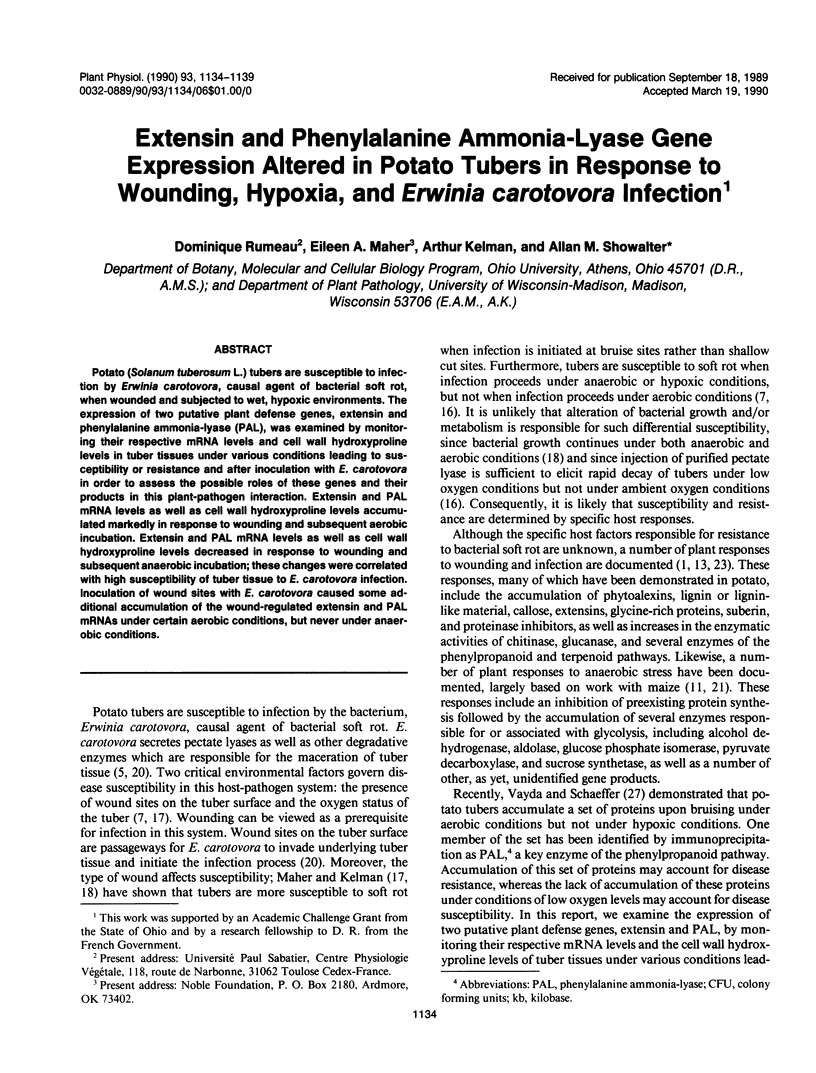
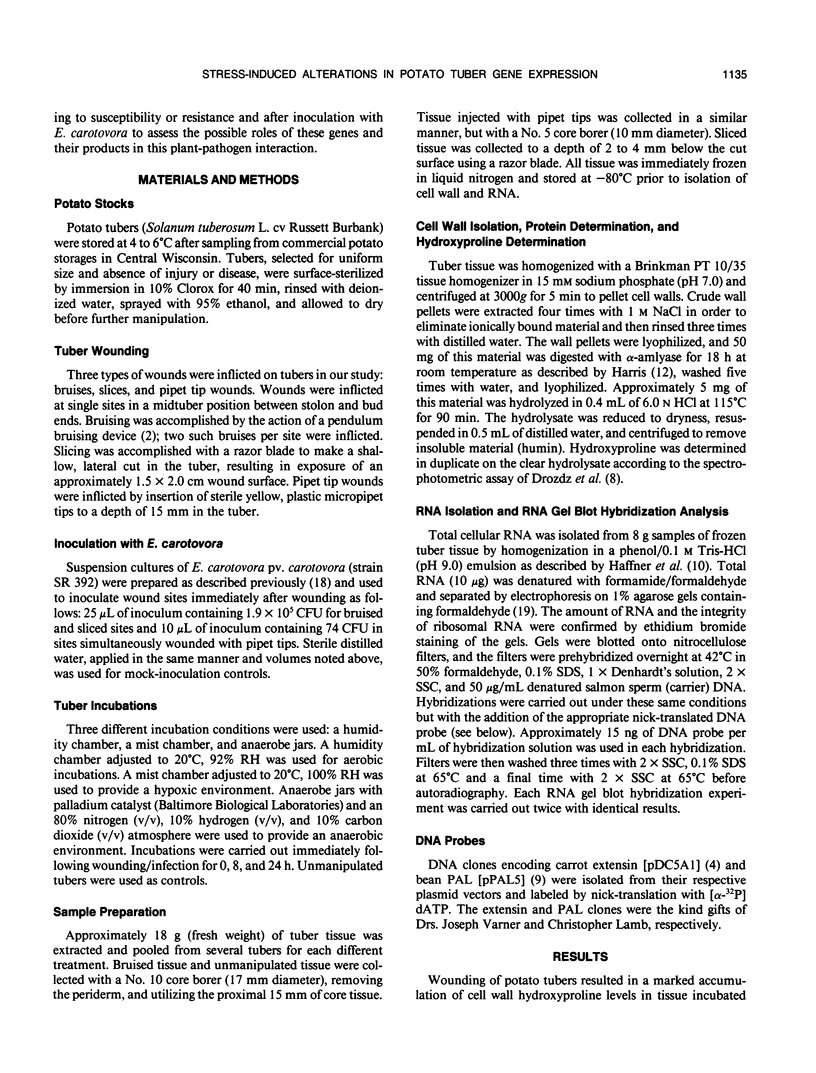
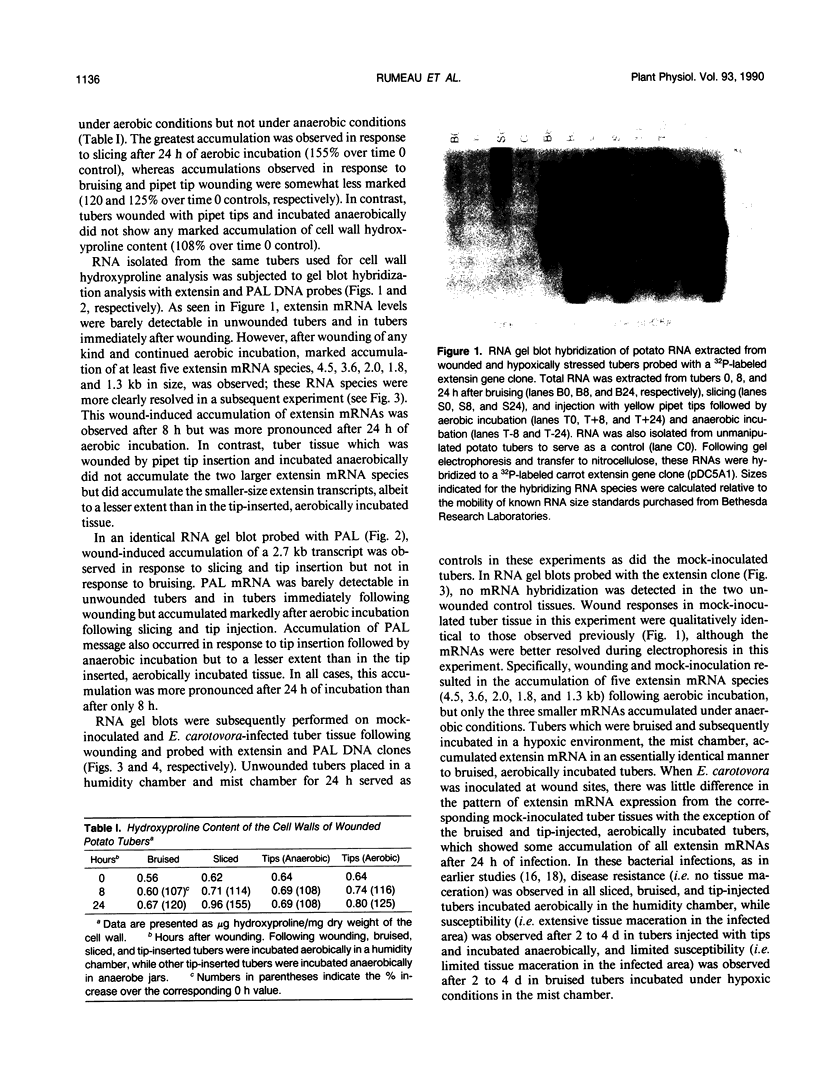
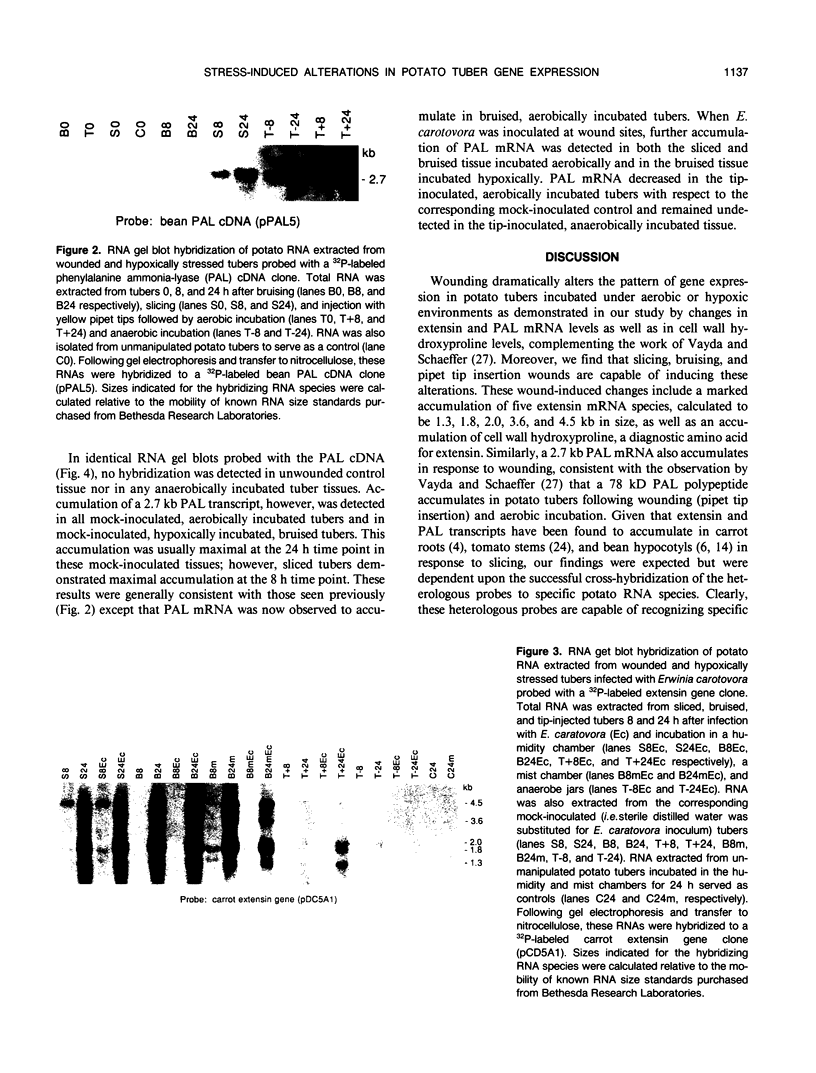
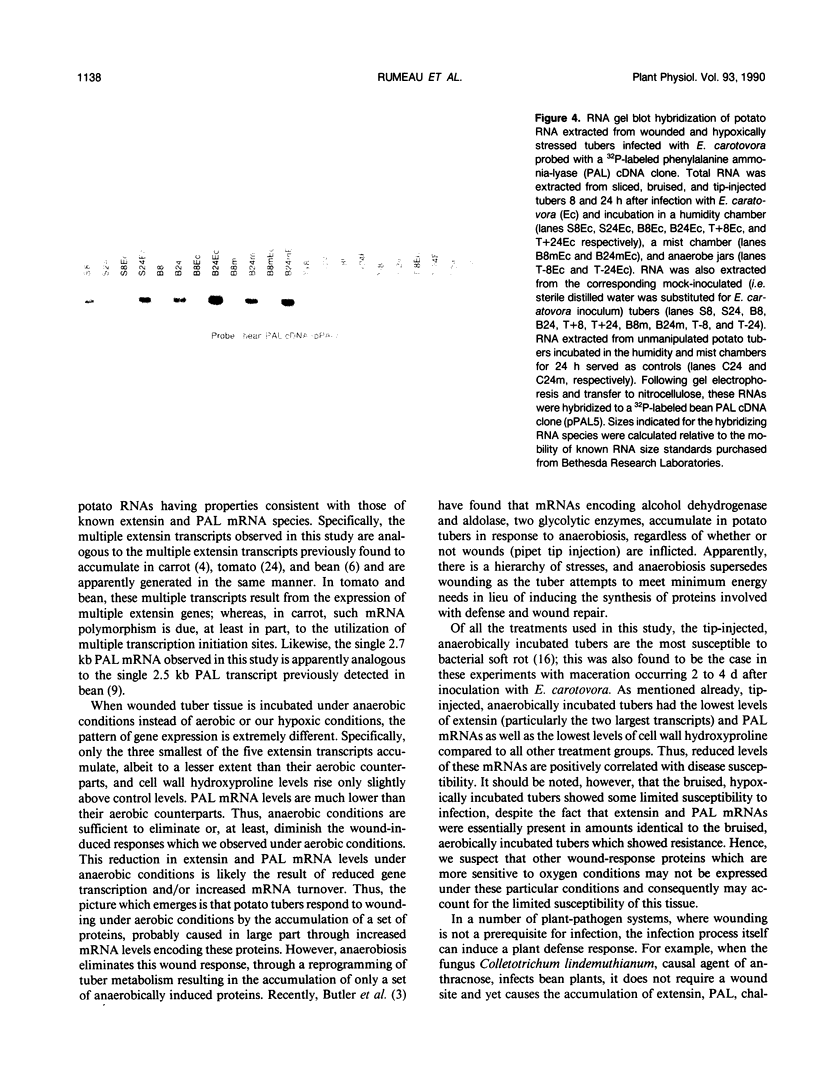
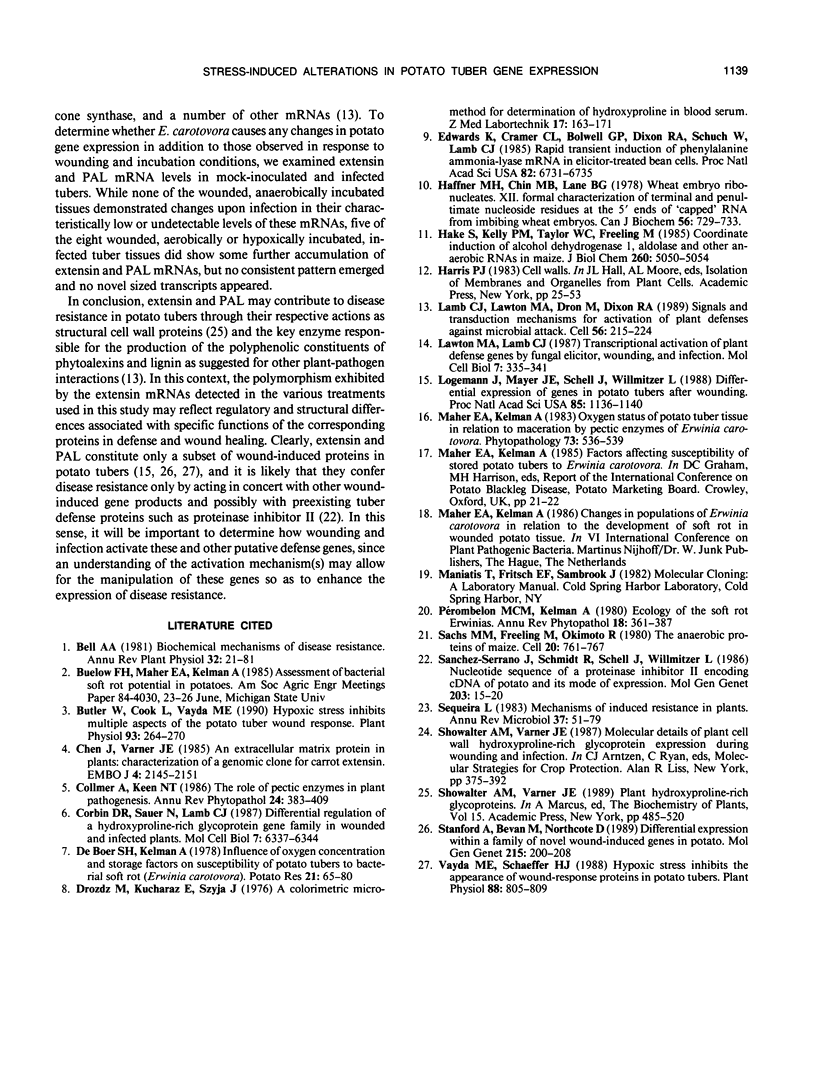
Images in this article
Selected References
These references are in PubMed. This may not be the complete list of references from this article.
- Butler W., Cook L., Vayda M. E. Hypoxic stress inhibits multiple aspects of the potato tuber wound response. Plant Physiol. 1990 May;93(1):264–270. doi: 10.1104/pp.93.1.264. [DOI] [PMC free article] [PubMed] [Google Scholar]
- Chen J., Varner J. E. An extracellular matrix protein in plants: characterization of a genomic clone for carrot extensin. EMBO J. 1985 Sep;4(9):2145–2151. doi: 10.1002/j.1460-2075.1985.tb03908.x. [DOI] [PMC free article] [PubMed] [Google Scholar]
- Drózdz M., Kucharz E., Szyja J. A colorimetric micromethod for determination of hydroxyproline in blood serum. Z Med Labortech. 1976 Aug 4;17(4):163–171. [PubMed] [Google Scholar]
- Edwards K., Cramer C. L., Bolwell G. P., Dixon R. A., Schuch W., Lamb C. J. Rapid transient induction of phenylalanine ammonia-lyase mRNA in elicitor-treated bean cells. Proc Natl Acad Sci U S A. 1985 Oct;82(20):6731–6735. doi: 10.1073/pnas.82.20.6731. [DOI] [PMC free article] [PubMed] [Google Scholar]
- Haffner M. H., Chin M. B., Lane B. G. Wheat embryo ribonucleates. XII. Formal characterization of terminal and penultimate nucleoside residues at the 5'-ends of "capped" RNA from imbibing wheat embryos. Can J Biochem. 1978 Jul;56(7):729–733. doi: 10.1139/o78-109. [DOI] [PubMed] [Google Scholar]
- Hake S., Kelley P. M., Taylor W. C., Freeling M. Coordinate induction of alcohol dehydrogenase 1, aldolase, and other anaerobic RNAs in maize. J Biol Chem. 1985 Apr 25;260(8):5050–5054. [PubMed] [Google Scholar]
- Lamb C. J., Lawton M. A., Dron M., Dixon R. A. Signals and transduction mechanisms for activation of plant defenses against microbial attack. Cell. 1989 Jan 27;56(2):215–224. doi: 10.1016/0092-8674(89)90894-5. [DOI] [PubMed] [Google Scholar]
- Lawton M. A., Lamb C. J. Transcriptional activation of plant defense genes by fungal elicitor, wounding, and infection. Mol Cell Biol. 1987 Jan;7(1):335–341. doi: 10.1128/mcb.7.1.335. [DOI] [PMC free article] [PubMed] [Google Scholar]
- Logemann J., Mayer J. E., Schell J., Willmitzer L. Differential expression of genes in potato tubers after wounding. Proc Natl Acad Sci U S A. 1988 Feb;85(4):1136–1140. doi: 10.1073/pnas.85.4.1136. [DOI] [PMC free article] [PubMed] [Google Scholar]
- Sachs M. M., Freeling M., Okimoto R. The anaerobic proteins of maize. Cell. 1980 Jul;20(3):761–767. doi: 10.1016/0092-8674(80)90322-0. [DOI] [PubMed] [Google Scholar]
- Sequeira L. Mechanisms of induced resistance in plants. Annu Rev Microbiol. 1983;37:51–79. doi: 10.1146/annurev.mi.37.100183.000411. [DOI] [PubMed] [Google Scholar]
- Stanford A., Bevan M., Northcote D. Differential expression within a family of novel wound-induced genes in potato. Mol Gen Genet. 1989 Jan;215(2):200–208. doi: 10.1007/BF00339718. [DOI] [PubMed] [Google Scholar]
- Vayda M. E., Schaeffer H. J. Hypoxic stress inhibits the appearance of wound-response proteins in potato tubers. Plant Physiol. 1988 Nov;88(3):805–809. doi: 10.1104/pp.88.3.805. [DOI] [PMC free article] [PubMed] [Google Scholar]






